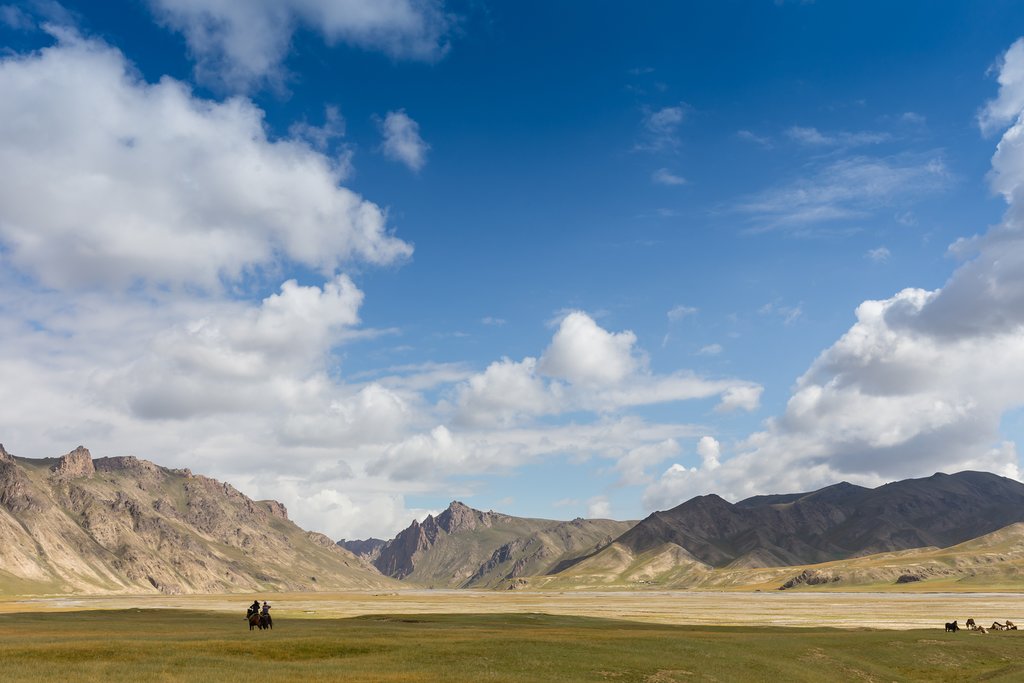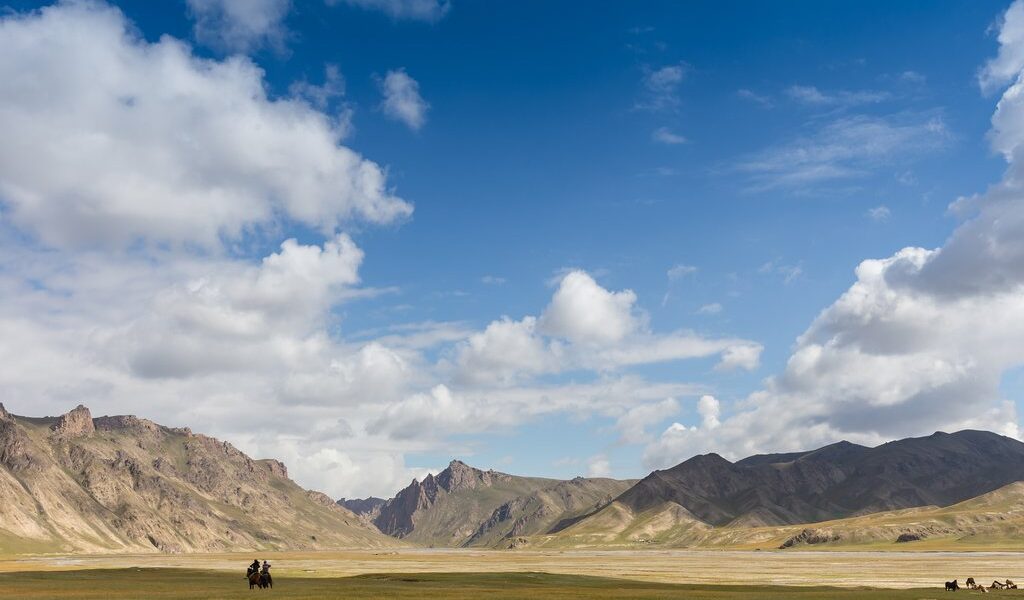
Mongolia’s geographic location in the heart of the Asian landmass – with no ocean to regulate its climate – results in long and frigid winters and a short, blustery spring. By contrast, Mongolia’s three-month summer bursts with activity – with Naadam sports festivals and opportunities to explore the countryside by Jeep, horseback or on foot. Autumn is the time to visit western Mongolia and experience the thrilling eagle festivals of Bayan Ölgii.
## Fast Facts: A Guide to the Best Time to Visit Mongolia
* Winter in Mongolia (mid-October through early March) ushers in a period of sub-zero temperatures and significantly curtailed daylight hours. Unless you are specifically seeking a quintessential winter experience, such as the thrill of dog sledding across the snow-covered landscapes or the serene patience of ice fishing on frozen lakes, it is generally recommended to avoid traveling to Mongolia during this season. The harsh conditions can make exploration challenging and limit the scope of available activities.
* Spring in Mongolia (March-April) is often characterized by strong, persistent winds and the unwelcome presence of unpleasant dust storms that sweep across the steppes. This season also finds livestock in a weakened state following the rigors of the long winter months, which consequently limits the opportunities for engaging in activities such as horse trekking through the countryside.
* Summer (July and August) presents the most favorable window for travel in Mongolia. This is when you have the highest probability of experiencing the nation’s famed Naadam festival, a vibrant celebration of Mongolian culture and athleticism. Furthermore, summer offers the ideal conditions for a wide array of outdoor activities, including exhilarating horse riding adventures and invigorating trekking expeditions. It is advisable to book your hotel accommodations well in advance, as they tend to fill up quickly around the time of the Naadam festival, particularly in popular destinations like Ulaanbaatar.
* Autumn in Mongolia (September-October) stands out as a particularly beautiful time to witness the stunning transformation of colors in the northern regions of Mongolia. Additionally, autumn is when the captivating eagle festivals take place in Bayan Ölgii, providing a unique opportunity to observe the ancient tradition of eagle hunting.
## An Overview of the Best Time to Visit Mongolia
For travelers who aspire to capture Mongolia at its most visually stunning, a visit during the mid-summer months is highly recommended. This period typically follows a spell of rain, which revitalizes the grasslands and infuses the landscape with vibrant life. Moreover, mid-summer presents the most conducive conditions for indulging in a variety of outdoor pursuits, such as embarking on horseback riding excursions, exploring the terrain on mountain bikes, enjoying leisurely boating trips, or taking refreshing swims in the country’s lakes and rivers.
If the art of angling appeals to you, the fishing season in Mongolia generally extends from mid-June to late September, offering ample opportunities to cast your line and reel in a prized catch. The exhilarating Naadam festivals, a highlight of the Mongolian cultural calendar, traditionally take place in July. While nearly every city and town hosts its own Naadam celebration, the exact dates can vary from year to year. However, some locations, such as Ulaanbaatar, maintain fixed dates for their Naadam festivities (July 11-12).
There are also those intrepid travelers who venture to Mongolia during the winter months, undeterred by the frigid temperatures. These adventurous souls seek to immerse themselves in the unique experience of nomadic life during the coldest part of the year. Conversely, the spring season, particularly the month of March, is often considered the least desirable time to visit Mongolia due to the prevalence of brown earth and disruptive dust storms. Autumn weather can be quite pleasant, but it is crucial for travelers to pack and be prepared with warm clothing to mitigate the risk of sudden cold snaps.
## Exploring Mongolia’s Diverse Regions
The expansive Gobi Desert to the south and the vast expanse of Siberia to the north serve as natural boundaries for the landlocked nation of Mongolia. The seemingly endless stretches of open and flat terrain create subtle transitions between the various climatic zones found throughout the country. One might journey for hundreds of miles and notice only slight changes in the landscape and vegetation until suddenly arriving in a region of mountains and forests, such as the area surrounding Lake Khvösgöl. Desert regions predominantly cover the southern part of the country and extend into the western provinces. In contrast, the central, northern, and eastern regions feature a diverse mix of plains and grasslands that flourish with the arrival of summer rains.
## Embracing the Low Season: November to April in Mongolia
From the beginning of November, the daily high temperature consistently falls below the freezing point and remains there until early March. In Ulaanbaatar, the average daily temperature in December plummets to a frigid -13°F/-25°C. The Gobi Desert tends to be a few degrees warmer than the rest of the country, while the northern regions experience even colder temperatures. The days during this season are noticeably shorter, with the sun setting between 5 pm and 6 pm in winter. As such, it’s recommended that you bring books and a deck of cards to help pass the time during long nights spent in the countryside.
To adequately prepare for the extreme cold of this season, it is essential to pack thermal underwear and layer two or three garments of warm clothing. While the majority of hotels in Mongolia have reliable heating systems, it is prudent to bring a sleeping bag as a precautionary measure in case of heating system breakdowns.
The long, clear winter nights in Mongolia offer remarkable opportunities for stargazing amidst the frozen steppes. A select number of ger camps remain open near Ulaanbaatar during the winter months. In addition, there are typically one or two ger camps that remain open in Khatgal, which is located near Lake Khvösgöl.
The main holiday during this period is Tsagaan Sar (Lunar New Year), a deeply cherished family-oriented celebration that spans three days. During Tsagaan Sar, families come together to share meals, particularly dumplings, which are consumed in copious amounts. A whole boiled sheep, proudly displayed on the dinner table, is nibbled on throughout the holiday. Travelers may be able to arrange a home visit during this holiday through a tour operator, allowing them to partake in the festivities and experience the warmth of Mongolian hospitality.
A handful of smaller festivals cater to tourists during the winter season. If you are someone who revels in cold climes and clear blue skies, consider attending the Lake Khvösgöl Ice Festival, which takes place in early March. This festival features a variety of games, ice fishing activities, and stunning ice sculptures. Another highlight in early March is the South Gobi Camel Festival, which is usually held in the town of Bulgan. This festival showcases an impressive gathering of approximately 10,000 camels that compete in contests, including races and camel polo matches.
Wintertime activities in Mongolia include dog sledding tours in Terelj National Park from December to February. Dog sledding is also available at Lake Khvösgöl in March. The Sky Resort near Ulaanbaatar offers opportunities for cross-country and downhill skiing, although the extreme cold conditions can limit the amount of time skiers can spend on the slopes.
While the weather gradually warms up during March and April, this period can be quite unpredictable, with occasional strong winds and dust storms. Landscapes tend to appear bleak during this time of year as the snow melts and reveals brown, grassless earth. Livestock are typically weak (and many unfortunately perish) during this period, making it a less than ideal time for horse trekking.
## Exploring the Shoulder Season: September to mid-October & May in Mongolia
September generally offers pleasant weather conditions across most of Mongolia, with an average high temperature in Ulaanbaatar of 60°F/15.6°C. This season presents the opportunity to witness the changing of leaves, as the landscape transforms into a vibrant display of colors. Although early snows can sometimes limit travel in the northern regions, the cooler climate makes autumn a particularly appealing season for visiting the southern part of the country.
The cultural highlights of this period are the eagle hunting festivals held in Bayan Ölgii province. During these festivals, proud eagle hunters (and huntresses) parade in their finest attire (think massive wool coats and fox fur hats) and compete in a variety of skill-based events. The festivals typically take place in late September or early October and include the Golden Eagle Festival near the city of Ölgii and the Altai Kazakh Eagle Festival in Sagsai.
May is also a good time to travel to Mongolia, with mild temperatures prevailing across the country (although ice may still cover Lake Khvösgöl). Ulaanbaatar hosts an international marathon towards the end of this month, offering races of varying distances to cater to runners of different skill levels.
## Enjoying the High Season: June to August in Mongolia
The average high temperature in Ulaanbaatar in July is a mild 62°F/16°C, with temperatures rarely exceeding 87°F/30.5°C during brief hot spells that typically last only a couple of days. This season is characterized by wildflowers blooming on mountainsides and livestock grazing lazily on the grassy plains. Travelers can partake in all sorts of outdoor activities, including horse riding, trekking, and mountain biking. Serious anglers may want to time their Mongolia visit for mid-August or early September, which is considered the prime season for catching Taiman (a carnivorous salmonoid). However, fishing is generally possible throughout the summer.
During the summer months, Ulaanbaatar’s cafe patios become bustling hubs filled with locals and travelers alike, all reveling in the warm weather. The festival highlight in the capital is Naadam (July 11-12), during which the city essentially shuts down to celebrate and witness the three manly sports of horse races, archery, and wrestling. While tickets are required to attend the stunning opening ceremony and wrestling events, the archery and horse races are free to the public. Tickets for the opening ceremony can be purchased through guesthouses, hotels, and tour operators. Alternatively, they can sometimes be found from scalpers outside the stadium, but these tickets tend to be located in the uncovered section of the stadium.
Don’t miss the grand celebration that takes place on Ulaanbaatar’s Sükhbaatar Square on the night of July 11. Another excellent way to experience the festival is to spend a night camping out at the horse race fields (40km east of UB), mingling with the jockeys and trainers and soaking in the atmosphere.
You don’t necessarily have to be in Ulaanbaatar on these specific dates to experience Naadam. The festival is celebrated nationwide in every city and town, and the smaller, countryside Naadams often offer a more authentic and interesting experience. The challenge can sometimes be finding information about these local Naadams, as the dates are usually not fixed or widely advertised. Some countryside Naadams with fixed dates include Khatgal (July 11-12) and Dalanzadgad (July 9-10). The Tourist Information Center in Ulaanbaatar can provide information and dates for countryside Naadams.
Hotels in Ulaanbaatar tend to get fully booked in July, particularly around the time of Naadam, so it is essential to plan your accommodation arrangements accordingly. After Naadam, a significant portion of Ulaanbaatar residents leave the city for the countryside, and many locals head to Lake Khvösgöl. Therefore, be prepared for crowds, especially on the western side of the lake.
August is often the most pleasant month to travel to Mongolia, following the droughts and heat waves that typically occur earlier in the summer. On the downside, rainy weather in August can sometimes slow travel, as roads can become muddy and difficult to navigate. Naadams organized specifically for tourists are sometimes held during this time, including the Nomadic Naadam.
**New word count: 1759**
B-1586

